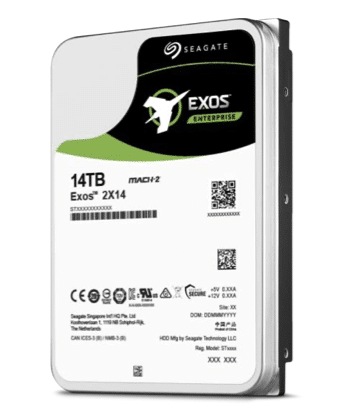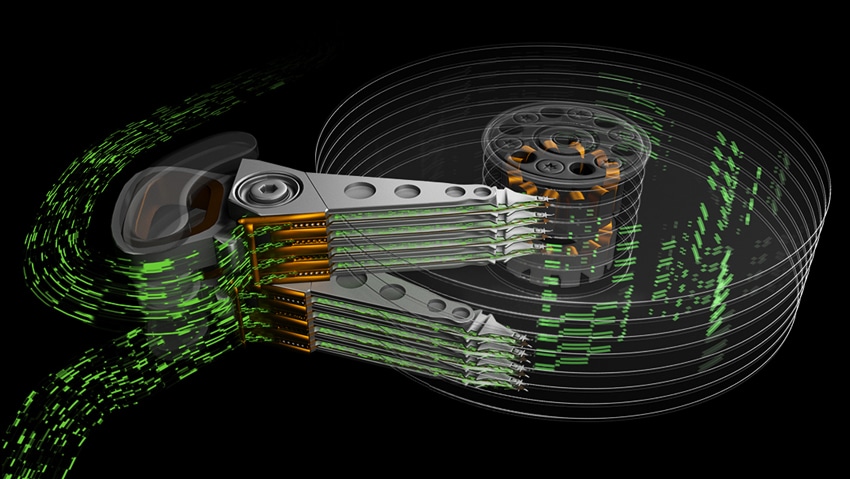At the company’s analyst event in February of this year, Seagate discussed their lineup of dual-actuator hard drives, a technology dubbed MACH.2. These drives have been shipping since 2019 and Seagate now has over a dozen customers using or trialing the technology. When combined with HAMR, these drives have the potential to both be very fast thanks to the twin actuators, but also very large. HAMR drives can grow much faster than PMR drives. Seagate has now shed some light on the capabilities of MACH.2 drives, releasing a data sheet for the Seagate Exos 2X14 that offers reads of 524MB/s.

What is Seagate MACH.2?
MACH.2 is the company’s name for its multi-actuator technology. As Seagate states, the performance of an HDD is limited by the number of actuators (the part of the drive that moves the heads over the media surface. If there were multiple actuators, theoretically one could increase the performance by the number of actuators added, assuming they don’t get in each other’s way. Seagate argued that the single actuator of an HDD was the main limiting factor in overall performance.

Adding more actuators will enable the drives to read different sets of information. In the case of two actuators, one could read two different sets of data at the top speed resulting in what appears to be double the performance. Not only would the performance double, but one could do so without changing the capacity, for instance, taking a 14TB HDD and then doubling the performance we see here. MACH.2 technology is also a way for HDDs to keep up in performance for their increase in capacity that had really taken off. MACH.2 can be used with other technologies as well including PMR and HAMR.
MACH.2 was first introduced in 2017 and has been shipping since 2019. Why it isn’t being talked about more is the fact that it is still in the technology-staging mode. Seagate states that when they hit 30TB per drive or above MACH.2 will become a standard feature. Considering how fast the top-end capacity has gone over the last few years, a 30TB HDD is possible within the next 12-16 months.
Their initial argument and bringing this up was four years ago and some things have changed. For one, SSDs are much more cost-effective and much higher in performance than they were four years ago. They can also go up to crazy high capacities in a single 2.5″ drive. Though they are much more expensive than HDDs. And hyperscalers still tend to use HDDs. The more things change, the more they stay the same…
Seagate Exos 2X14 Tech Highlights
The Seagate Exos 2X14 is a version of the Seagate Exos X14 that leverages the MACH.2 technology. Both drives are 3.5-inch HDDs that leverage the SAS interface. Both are helium sealed which is said to lower TCO. The main difference is the performance. The X14 can hit up to 261MB/s and 170 IOPS read while the 2X14 is said to hit 524MB/s and 304 IOPS read. The latter’s performance is close to that of a SATA SSD. The 2X14 consumes more power at 7W versus the X14’s 5W average. The 2X14 has 7TB per logical unit. Both drives had 2.5 million hours MTBF.
Seagate Exos 2X14 Key Specs
| Interface | 12Gb/s SAS |
| Capacity | 14TB |
| Hyperscale (4Kn) | ST14000NM0001 |
| Capacity per Logical Unit | 7TB |
| Mean Time Between Failures (MTBF, hours) | 2.5 million |
| Reliability Rating @ Full 24×7 Operation (AFR) | 0.35% |
| Nonrecoverable Read Errors per Bits Read | 1 sector per 10E15 |
| Power-On Hours per Year (24×7) | 760 |
| 4Kn Sector Size (Bytes per Sector) | 4096 |
| Limited Warranty (years) | 5 |
| Performance | |
| Spindle Speed (RPM) | 7200RPM |
| Max. Sustained Transfer Rate OD (MB/s,MiB/s) | 524, 500 |
| Random Read/Write 4K QD16 WCD (IOPS) | 304/384 |
| Average Latency (ms) | 4.16 |
| Interface Ports | Single |
| Power Consumption | |
| Idle A (W) Average | 7.0W |
| Random Read/Write 4K/16Q (W) | 12.1/8.7 |
| Sequential Read/Write 256K/16Q (W) | 13.4/11.8 |
| Power Supply Requirements | +12 V and +5 V |
Final Thoughts
If the price is right, the Seagate Exos 2X14 will offer hyperscalers the ability to double their performance in the same footprint. This is definitely something that StorageReview would like to take a crack out in the performance department. We love faster and faster flash but HDDs still hold a certain spot in our testing hearts.




 Amazon
Amazon